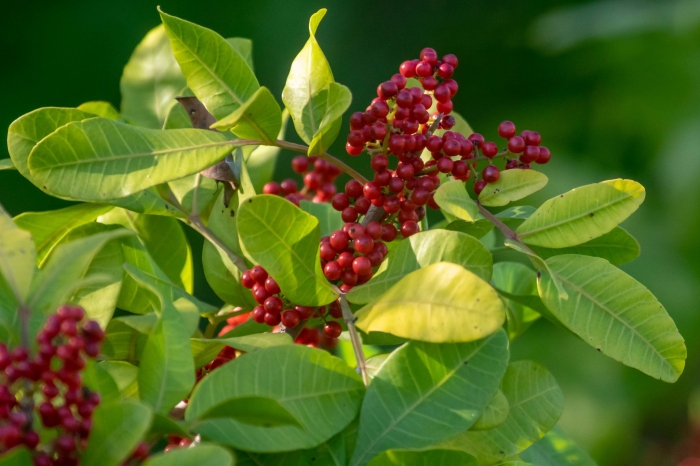Brazilian Peppertree
(Schinus terebinthifolia)
Brazilian Peppertree (Schinus terebinthifolia)
/
/

Niki Robertson
CC BY 4.0
Image By:
Niki Robertson
Recorded By:
Copyright:
CC BY 4.0
Copyright Notice:
Photo by: Niki Robertson | License Type: CC BY 4.0 | License URL: http://creativecommons.org/licenses/by/4.0/ | Rights Holder: Niki Robertson | Publisher: iNaturalist | Date Created: 2020-01-21T15:25:03-08:00 |
























































Estimated Native Range
Summary
Schinus terebinthifolia, commonly known as Brazilian Peppertree, is an evergreen shrub or small tree native to subtropical and tropical regions of South America, including Brazil, Argentina, and Paraguay. It typically reaches a height of 7–10 meters and can spread widely. The Brazilian Peppertree is adaptable to various habitats, from coastal dunes to riparian zones, where it often forms dense thickets. Its form is irregular, with a sprawling habit and a shallow root system that can disrupt sidewalks and foundations.
The Brazilian Peppertree is known for its attractive compound leaves, which are aromatic when crushed, and its bright red berries that appear in dense clusters, providing a striking visual display. The small white flowers bloom in axillary clusters and are quite showy, attracting pollinators. It is commonly used in ornamental landscaping in frost-free regions for its foliage and fruit, and it can serve as a privacy screen or hedge. This species prefers full sun but can tolerate part shade, and it is drought-tolerant once established, requiring low to medium amounts of water. It thrives in a range of soil types, provided they have medium drainage. However, it is important to note that Brazilian Peppertree can be invasive outside its native range, particularly in places like Florida, where it disrupts local ecosystems. It is also susceptible to pests like the Brazilian peppertree psyllid.CC BY-SA 4.0
The Brazilian Peppertree is known for its attractive compound leaves, which are aromatic when crushed, and its bright red berries that appear in dense clusters, providing a striking visual display. The small white flowers bloom in axillary clusters and are quite showy, attracting pollinators. It is commonly used in ornamental landscaping in frost-free regions for its foliage and fruit, and it can serve as a privacy screen or hedge. This species prefers full sun but can tolerate part shade, and it is drought-tolerant once established, requiring low to medium amounts of water. It thrives in a range of soil types, provided they have medium drainage. However, it is important to note that Brazilian Peppertree can be invasive outside its native range, particularly in places like Florida, where it disrupts local ecosystems. It is also susceptible to pests like the Brazilian peppertree psyllid.CC BY-SA 4.0
Plant Description
- Plant Type: Shrub, Tree
- Height: 15-30 feet
- Width: 10-20 feet
- Growth Rate: Moderate
- Flower Color: White
- Flowering Season: Summer, Fall
- Leaf Retention: Evergreen
Growth Requirements
- Sun: Full Sun
- Water: Medium
- Drainage: Medium
Common Uses
Bird Garden
Natural Habitat
Native to subtropical and tropical regions of South America, adaptable to various habitats including coastal dunes and riparian zones
Other Names
Common Names: Christmasberry-Tree, Brazilian Pepper-Tree, Christmas Berry, Christmasberry, Florida Holly, Warui, Brasiliaanse Peperboom, Pimienta De Brasil, Copal, Faux Poivrier
Scientific Names: , Schinus terebinthifolia, Schinus mucronulata, Schinus aroeira, Schinus terebinthifolia var. damaziana, Rhus heptaphylla, Schinus terebinthifolia var. selloana, Rhus schinoides, Rhus trijuga, Sarcotheca bahiensis
GBIF Accepted Name: Schinus terebinthifolia Raddi